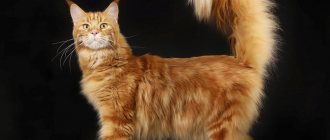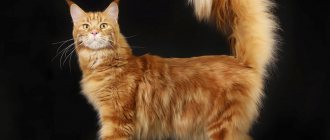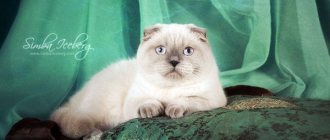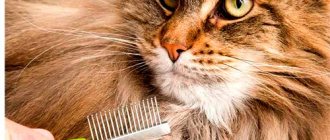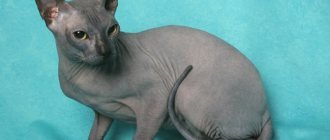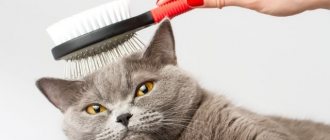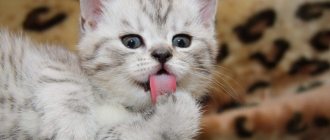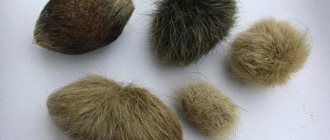Ginger cats are very popular. And it’s not surprising - this common cat color pleases the eye and lifts the mood. “Ryzhiki” are often found on the streets, but they can also be seen at any cat show. Red (more precisely, red) color is allowed by the standards of many breeds, although it is not the only “signature” color for any breed.
And yet this is a special color. Most colors of cat fur coats are determined by the black pigment gene. And the red color is determined by the “personal” red pigment gene, which has some interesting properties.
Firstly, most ginger cats are males. The pigment genes are localized on the sex X chromosome, and since the cat has only one (received from the mother), his chances of being born red are higher. A cat has two X chromosomes and will only be born red if it receives the red pigment gene from both parents.
Secondly, there are no red cats without a pattern. The fact is that some cats (including red ones) have a special gene called “non-agouti”, which does not allow the pattern (tabby) to appear. However, the red pigment gene “neutralizes” the effect of the non-agouti gene, so there are always at least traces of tabby on a red cat’s coat.
So it seems that a red cat without any signs of stripes, stains and spots cannot have the red pigment gene. Most likely, its color is cinnamon, and this is the work of the black pigment gene.
The remarkable red coloration is often found in the following breeds.
British (shorthair and longhair)
A nice, strong body, a cheeky muzzle and thick plush fur are for some reason associated with blue or chinchilla colors. In fact, the standard allows for almost all colors, and the red Briton is an impressive sight!
At one time, Persians were used for breeding by the British, so the birth of long-haired kittens was common. The “heavy Persian heritage” has long been considered a breed defect. Only recently have enthusiasts managed to achieve recognition of a new breed - the British Longhair.
Don Sphynx and St. Petersburg Sphynx (Peterbald)
The calling card of both breeds is the absence of hair. The standards of both allow any colors. Both Donchaks and Peterbalds come from the same cat, born in Rostov-on-Don in the late 80s. They equally love heat and hearty food. How are they different from each other?
Build and character. Donchaks are strong, muscular cats, with a wedge-shaped head with wide cheekbones and large ears set high and wide. They have a friendly, sociable character. Peterbalds are much more graceful - a slender body on thin high legs, a long tail, an elongated head and huge ears. Being descendants of Orientals and Siamese, Peterbalds are very active, talkative and affectionate.
Turkish Angora
An elegant large cat with a wedge-shaped head, long soft hair with virtually no undercoat is considered one hundred percent blonde. But in fact, the angora can have different colors, including red.
Other breeds whose standards allow red color: Siberian, Norwegian Forest, Oriental, Devon Rex, Selkirk Rex, La Perm, Canadian Sphynx.
The popularity of ginger cats is associated not only with their “joyful” appearance. According to legend, they bring success and protect the owners from the negative energy of bad people.
Red-colored male and female cats are not uncommon. However, this coat color is most often found among yard dwellers. This is due to the fact that street animals do not experience any particular difficulties with mating and do not depend on the plans of the breeders.
In this article we will tell you: which gene is responsible for the red pigment, which color variations are most common and among which breeds.
Scottish Straight (Scottish Straight cat)
Gentle, sweet, so fluffy and very charming, the Scottish Straight cat is a dream for many pet lovers.
Do you want to know in more detail who a Scottish cat is : what are the features of its external and internal qualities, what differences does its standard have, how to care for it? Then you are where you need to be.
History of the origin of the breed
The Scottish Straight has recently become an independent breed. This is due to the fact that Scottish Straight kittens are “children” of the Scottish Fold cat, which (once they reach the age of one month) have straight ears.
This division of the breed became necessary, since for the normal health of cats of this breed (without mutations that are typical when crossing two fold-eared individuals), it is necessary to cross a fold-eared cat with a straight-eared cat. Therefore, these animals were recognized as a separate breed - the Scottish Straight.
Description of the breed
The Scottish Straight cat has some features that are unique to him. If we compare this breed with the “British” (with which it is often confused), we can identify such characteristic features of the Scots as:
The life expectancy of a Scottish cat depends on: health, feeding, habitat, living conditions, etc. A more detailed description of the cat presents its breed standard, by which you can understand what a real Scottish Straight looks like.
External features and character
Scottish cats are very smart and sweet. They have a rather flexible and modest character, not requiring excessive attention to their person. They have a rather calm character. They are especially attached to one of the family members, but do not deprive others of their attention. Scottish cats do not really like to sit on their hands, preferring
Source
Features of ginger cats
Felinologists call the red coat color red. This color is found in different breeds, but it cannot be called the calling card of any of them.
The color of the coat is determined by the black pigment gene. The red pigment gene is responsible for the red color. It is interesting that among felines, mostly cats have red fur coats. In addition, a mandatory attribute of the red color is the tabby pattern. There are no monochromatic fire coats in nature. Stripes, spots, marble patterns are often combined with white and black colors.
At birth, kittens receive one chromosome each from their mother and father. Females have two sets of colors - on the “X” chromosome (XX), and males - on the “X” and “Y” chromosomes. If the parent pair has the red pigment gene, then the entire litter will be red.
If the father has the black pigment gene, the mother will give birth to tortoiseshell girls and red-haired boys. If both parents have the gene for black pigment, the offspring will turn out black. If the father is a carrier of the red pigment gene, the litter will contain tortoiseshell cats and black seals.
Tortoiseshell cats - a box with a surprise. A mother of this color gives birth to kittens of any color. Black cats can produce tortoiseshell or black girls, red and black boys. From ginger cats, tortoiseshell and ginger cats, black and ginger cats are born.
Reference. Knowing the color of the parent pair, you can calculate the probability of the appearance of red kittens, taking into account gender.
Character
It seems to non-professionals that coat color has nothing to do with the character, habits, mental abilities and temperament of cats. Experts, in turn, note that ginger cats are distinguished by ingenuity, cunning, audacity, independence and a lively mind. It is the sunny fluffies that are better trained than other felines. They are playful, inquisitive and active.
Orange kittens show increased interest in humans and are distinguished by enviable obedience. Animals with sun-colored fur coats are kind and forgiving towards children. Purrs generously forgive pranks and do not harbor resentment in their hearts.
The character of cats also depends on the breed. Persian beauties are affectionate, soft, and compliant. The British are individualists and snobs. Siberian cats have an easy-going character and a gentle disposition. Abyssinians are curious creatures who love to poke their nose into every corner.
What color will a gray cat's kittens be?
Dear visitor, if you notice any error or inaccuracy in the operation of our website, write to us at [email protected] uz. Or use the feedback form. We will correct all inaccuracies and errors in the coming days. Thank you!
Sooner or later, people involved in cat breeding are faced with the problem of how to find out the color of future kittens and how to control it. In this article I will talk about the genetics of the red color of cats.
I will tell you about how the red color of cats appears, from which cats with cats you can predict the appearance of red kittens and why there are practically no red cats.
First of all, we’ll tell you a little about genetics (full information: genetics of cat colors), so that later it will be more clear how red cats appear. For now, we will not take into account such factors as the pattern of cats (spots, marbles, stripes), uniform coloring of each hair, white inclusions and other features that may affect the color of cats. Now we will talk about 2 main colors “red” - “not red” (the gene responsible for their manifestation is called “orange” (English)). For ease of understanding, let’s assume that “red” is cream and red, “not red” is blue, black, lilac and chocolate (in the future we will call them all “black”), and “tortoiseshell” is chocolate-colored. red, blue-cream, black-red and lilac-cream colors.
Now let's talk about genetics. A cat has 2 sex chromosomes “XX”, a cat has another one – “XY”. The “orange” color gene is located on the “X” chromosome, because it is larger in size; there is not enough space for this gene on the “Y” chromosome. This is why in a cat both “X” chromosomes form the color of the cat (“red” - “not red”), and as a result of which the cat is completely “red” (when its “X” chromosomes contain the “orange” gene), or completely “ black" (when its "X" chromosomes contain the "non-orange" gene), or tortoiseshell, when one of the "X" chromosomes
Source
Blog about British cats Everything you wanted to know about British cats and more...
Color options
Other tones that descendants inherit from their ancestors also participate in the formation of coat shades. All attempts by breeders to create a uniform color were unsuccessful. Any red color looks patterned.
- White and tan is the most popular option. The white gene in this color combination is dominant and suppresses the white spotting of solid colors.
- Gray-red appears if one of the parents has the D gene, which is responsible for color intensity. The most spectacular combination is red, white and gray. This color is often found among outbred cats.
- A red tabby or tabby appears as fine lines, a clear outline of the upper and lower eyelids, and an "M" shape on the animal's forehead.
- The red tabby is a very varied and interesting color that looks like a shaded tabby. Contrast comes in different intensities.
- Black and red - tortoiseshell. Its carriers are cats. The color is often found in Persians and Maine Coons.
Tortoiseshell color (black and red)
Possible eye colors
In red cats, the iris seems especially bright and contrasts favorably with the coat color. The most attractive combination is a red fur coat and green eyes. However, eye color can be of any color: green, orange, yellow, blue of varying intensity.
What do dreams involving cats portend?
The interpretation of dreams involving cats is based on the shade of the animal's fur. Red color in a dream means lies and envy. Often the appearance of such an animal is a consequence of the use of magical actions in relation to a person who is dreaming. If a cat of any color washes itself, a pleasant meeting is possible or success in business awaits. The appearance of a tricolor animal in a woman’s dream indicates the presence of a rival. In addition, such a cat can promise quarrels and conflicts.
The appearance of a black cat in a dream always portends something negative. For a girl, the dream promises betrayal by her lover, for a married woman - a quarrel with her other half. A man who sees a black cat in a dream may face failures and disappointments.
Oddly enough, a dead black cat in a dream is a good sign. This serves as an omen of the onset of a white streak in life. Existing problems should soon be resolved, and reconciliation with loved ones may also occur.
Video: why cats dream
Top best breeds of red cats
The top most popular breeds of ginger cats are headed by Persians, followed by the British and Scots. Exotics and Bengals are gaining popularity. Purebred Maine Coons attract attention with charming tassels on their ears and long silky fur. In addition, the list of popular breeds includes: Abyssinian and Siberian cats, Kurilian Bobtail, Turkish Van, Cymric, Savannah, Toyger, Somalia.
Persian
When you mention the Persians, your imagination pictures a well-fed, fluffy ginger cat. The red color of representatives of this breed is not too bright, it is rather creamy. Persians are loving and sociable. They easily find a common language with all family members.
The fur is thick, long, soft, and easily tangled. A lush collar adorns the neck, shoulders and chest. Such a fur coat requires careful care, and first of all, daily combing.
British
The British cat is associated with the color blue, but saffron milk caps are also common among representatives of this breed. The sunny shade is very rich and bright, and in combination with plush fur it looks amazing. The breed standard allows for 250 color combinations, but more or less solid colors are preferred.
Sunny Britons have coarser guard hairs, so the animals look larger due to the protruding hairs. The undercoat and guard hairs should be of the same tone without inclusions. The chin, tip of the tail and belly may be lighter.
Scottish lop-eared
The distinctive feature of the Scottish Fold is its round, ball-like head, flattened muzzle and drooping ears. The wool is fluffy, “cloudy”, very soft and pleasant to the touch. There are 1-3 folds on the ears.
Red color is rare. It is considered real luck to have a charming red-haired Scot. There is a pattern on a red background, most often a tabby.
Abyssinian
An intelligent and energetic Abyssinian has a strong and muscular body, long limbs and tail, a long neck, a wedge-shaped head, and large ears. The coat is thin, shiny, and harsh to the touch.
Representatives of this breed are flexible, independent, curious, loyal, and sociable. The red color of the coat is dark, rich, closer to copper, the tips of the guard hairs are dark in color.
Kurilian Bobtail
The Kuril Bobtail is a rare breed native to the Kuril Islands.
There are two varieties - short-haired and long-haired. A distinctive feature of the breed is its short tail. The body is strong and muscular, slightly tilted forward, the paws are large, the head is wedge-shaped, and the eyes are large.
Cats skillfully have a free character. They are affectionate, loving, inquisitive, and quickly become attached to people.
Orange color mixed with white and tabby is quite common.
Exotic
Exot is a close relative of the Persian. The animal has the same flattened muzzle and snub nose, strong build and square body. The coat is short and plush. One of the colors is red.
By nature, exotics are calm and good-natured. They are smart, playful and cheerful.
Siberian
Siberians are brave, loyal cats, born hunters. The animals have luxurious, long hair and a thick double undercoat. The iris of a rich orange-amber color evokes the admiration of connoisseurs of this breed.
The chic fur coat has light stripes and white inserts on the paws and shirtfront.
Maine Coon
The Maine Coon is a bright, presentable cat that resembles a lynx. Despite its serious appearance, it is a peaceful, responsive animal that can get along with all family members.
The most common color is white and red. Depending on the combination of tones, the following types are distinguished:
- bicolor - 50/50 white and red;
- harlequin - several red spots on the body;
- van - red head and ears;
- white tuxedo - against the background of the red color there is a white spot on the chest and white socks on the paws.
Turkish van
The Turkish Van is a semi-longhaired cat without undercoat. Red or chestnut spots with ring inserts at the base of the ears, on the body and tail stand out against the main white background.
Wool does not allow water to pass through, allowing Vans to swim to their heart's content.
Somalia
The Somali cat is a beauty with copper fur. Abyssinian is its closest relative. The Somali has a thick, long coat. The fluffy tail looks especially impressive.
There are dark spots on the head and tail. The iris is bright green. Representatives of the breed are smart, tactful, calm, patient and very sociable.
Cymric
Cymrik is a very calm, highly intelligent, people-oriented cat. Representatives of the breed were nicknamed little bear cubs due to their long, thick fur, compact build, rounded muzzle and small tail. Colors: tortoiseshell, white marble on a red background.
American Curl
The American Curl is a young breed of cat with curled ears. Animals are very calm and reasonable, have a balanced character. The coat is thin and soft, long or short.
Basic rules of cat genetics
2. Only the parents' colors determine the color of the kitten. The colors of other cats present in the pedigree do not have a direct effect on the color of the kitten;
5. To produce a genetically red or genetically cream-colored cat kitten in the litter, it is necessary that the father be genetically red or genetically cream, and the mother must also have a red or cream color in her genotype;
6. Dominant characteristics (dominant colors: white, veiled, shaded, smoke, tabby, bicolor, etc.) cannot skip a generation. They cannot pass, for example, from grandfather to grandson without manifesting themselves in the father;
8. Two parents of a recessive color (cream, blue, etc.) cannot produce a kitten of a dominant color (black, red, tortoiseshell, etc.);
11. A veiled/shaded kitten must have at least one parent who is either veiled/shaded or tabby;
12. A veiled/shaded parent can produce a smoky kitten, but a smoky parent cannot produce a veiled/shaded kitten;
14. All red cats have some degree of tabby. The ability to produce tabby offspring depends on whether the red cat (or cat) is a true tabby, i.e., whether it has a tabby parent or a veiled/shaded one, or whether it is simply a red cat with an outward tabby pattern. A red tabby, unless it is a true tabby, cannot produce a tabby offspring of any other color unless it is bred to a true tabby (or a veiled/shaded one);
17. Multi-colored individuals (tortie, blue-cream, tortoiseshell and white, blue-cream and white, tortoiseshell smoky, etc.) are almost always cats, but m
Source
How do a white cat and a gray cat get a red kitten? It's simple - from mom cat! And now a little more detail. The genetics of cat color are more complex than those of humans, and inheritance is more bizarre. Blonde parents can never give birth to a brunette child - such simple rules do not apply to cats. More precisely, the rules remain simple, there are simply many more “components”. The fact is that the color of cats is encoded by several genes. The appearance of a cat is determined not only by the gene responsible for the actual color of the coat, but also for the color “in general”, and for the presence (absence) and size of spots. In addition, the color gene is tightly linked to the sex chromosome. In humans, say, hair color is inherited regardless of gender. In cats, the color of the coat is inherited along with the female sex chromosome X. It turns out that a girl kitten can get color from both mom and dad, but the color of the coat of a boy kitten depends on the color of the mother cat (and her parents), i.e. e. inherited on the maternal line. First of all, the color of the coat is determined by the pair “there is color - there is no color.” The second option is true white cats - albino cats. By the way, this is a rarity, since the “color presence gene” is dominant (predominant): it alone is enough for the coat to “appear” at least some color. A true white cat can only be achieved if it inherits the “no color gene” from both parents. The second point is the color itself. In essence, there are only two main “cat” colors – black and red. Moreover, they are encoded by one gene: if it is “on”, it will turn out red, if it is turned off, it will turn out black. This particular gene is inherited only along with the X chromosome. Several interesting conclusions follow from this. Because cats only have one X chromosome, they can only inherit one variant of the gene. Consequently, the color of the cat’s fur is uniform. Cats have two X chromosomes, meaning they can inherit
Source
Breeds of long-haired red cats
The British cat can be short-haired or long-haired. The second option was obtained by crossing the British with Somalis and Persians. Representatives of the breed look great in white and red color.
The list of long-haired breeds with the red color gene also includes:
- Maine Coon;
- Somalia;
- Persian;
- Scottish lop-eared;
- van;
- exotic;
- angora;
- Siberian cat;
- American Curl;
- Napoleon.
Shorthair
List of shorthaired ginger cats:
- Abyssinian cat;
- Kurilian Bobtail;
- Cymric;
- savannah;
- toyger;
- Bengal;
- wild cat - caracal;
- Ural rex.
Nuances of care
There are no special rules for caring for red cats. When choosing grooming products, owners should focus on the type of coat and its length. To comb long-haired breeds, slicker brushes, fine-tooth combs and stiff brushes are used. For short-haired breeds with a thick undercoat, furminators are suitable, as they perfectly remove dead hairs and do not injure the guard hairs.
Bath days are held no more than once every six months, unless the cat herself doesn’t mind taking a bath. Famous water lovers include Bengals, Maine Coons and Turkish Vans. For example, the Scots and British are terrified of water and hate swimming.
Characteristic diseases
The relationship between coat color and the health of cats has not been established. It is known for certain that animals with a red color are more predisposed to allergic diseases and tolerate anesthesia less well.
Interesting facts and signs about ginger cats
Red cats often become heroes of films, comics, cartoons, and TV series. The most famous movie characters are the plump red cat Garfield and Puss in Boots from the cartoon “Shrek.” Red-haired beasts made a splash at the Disney film company! This includes Thomas O'Malley from the cartoon "The Aristocats" and the Cheshire Cat from "Alice in Wonderland."
Fans of Audrey Hepburn will remember the red cat in the movie Breakfast at Tiffany's. Potter lovers will not forget Crookshanks, Hermione’s unusual friend (pictured below).
If in ancient times black cats were feared and considered fiends of hell, then red furry cats were revered and called amulets, fearless defenders of the home.
There is an opinion that if a ginger cat takes care of a sick person, it means that recovery will come soon.
They used to believe that if a ginger cat comes into a house, it brings warmth and harmony. A fiery red cat in a person’s home means wealth.
Cats are excellent diagnosticians and healers. They are placed on the sore spot, and after a while the person notices that the pain and discomfort go away.
To improve family relationships, people adopted a sunny kitten.
Reference. Sometimes owners love their pets so much that they bequeath entire fortunes to them. A cat named Blackie is considered the richest cat in the world. The owner bequeathed her 15 million pounds sterling.
There are some signs associated with the behavior of red cats. For example, if an animal greets a guest warily, then most likely the person has bad thoughts.
If the cat does not lag behind the owner and asks to be held, perhaps it feels negative energy and is trying to remove it.
If a ginger cat crosses the owner's path from left to right before a trip, it is better to reschedule plans or delay them for half an hour.
The cat comes into the house
If a cat comes into the house, you cannot kick it out. He needs to be sheltered, because he brings happiness. You cannot kick out those kittens that do not come on their own, but are brought by children. Kids feel other people's energy much better than adults. If they brought an animal, it means they know on an intuitive level that it can protect them.
If the cat came into the house on its own, it must also be left. It will bring good luck, attract wealth and protect from troubles.
If a cat has strayed, but there is no way to leave it, then you need to feed and warm the animal. Afterwards you need to take care of her home. If you do all this, then good luck will come soon.
If a cat suddenly comes to your house, you need to pay for it. Three coins of any denomination are thrown onto the road, and gratitude is offered to fate for good luck.
If a strange cat appeared on the threshold, stood for a while and left, this is also considered a sign. Its interpretation depends on the color of the animal. If a red or black kitten arrives, the owners of the house will receive a monetary profit. Happiness and love - this is what a white or gray cat comes to.
If a kitten comes to the house of a married couple, then they will have an addition to the family. If a cat attaches itself to lonely people, it may promise a wedding.
If a neighbor's kitten strays, it cannot be kicked out or taken back to its owners. When the time comes, he will leave on his own. The baby who has settled down needs to be fed. Perhaps he came to scare away misfortune or warn the owners of trouble. The arriving kitten cannot be given away, because then it will not be able to protect it from harm.
A nested kitten is often considered a messenger from the other world. Along with him come the souls of deceased relatives. This is how they convey some kind of message or warn about impending misfortune, so a kitten that has become stuck cannot be kicked out. You need to keep it. If you kick out a nested kitten, this will bring misfortune to people, which will last for 7 days.
When a pregnant cat comes home and starts giving birth, you need to adopt her kittens. This will bring good luck for many years.
A stranded kitten cannot be kept in the house. If he wants to leave, you need to let him out. This will mean that the kitten has completed its mission and its services are no longer needed here.
